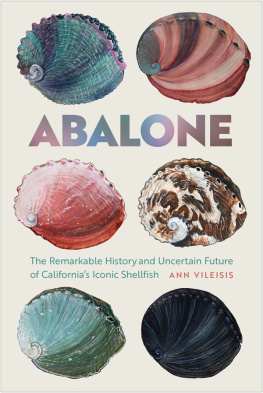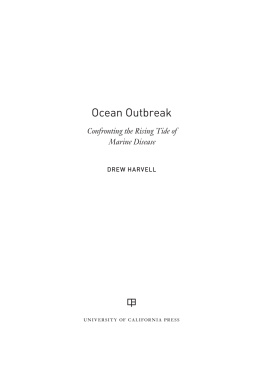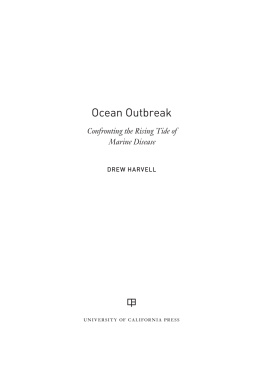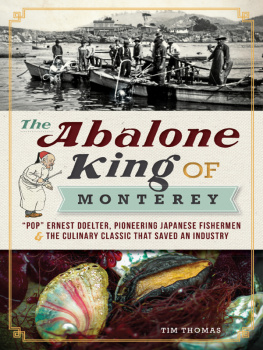Vileisis Ann - Abalone
Here you can read online Vileisis Ann - Abalone full text of the book (entire story) in english for free. Download pdf and epub, get meaning, cover and reviews about this ebook. publisher: Oregon State University Press, genre: Home and family. Description of the work, (preface) as well as reviews are available. Best literature library LitArk.com created for fans of good reading and offers a wide selection of genres:
Romance novel
Science fiction
Adventure
Detective
Science
History
Home and family
Prose
Art
Politics
Computer
Non-fiction
Religion
Business
Children
Humor
Choose a favorite category and find really read worthwhile books. Enjoy immersion in the world of imagination, feel the emotions of the characters or learn something new for yourself, make an fascinating discovery.
- Book:Abalone
- Author:
- Publisher:Oregon State University Press
- Genre:
- Rating:4 / 5
- Favourites:Add to favourites
- Your mark:
- 80
- 1
- 2
- 3
- 4
- 5
Abalone: summary, description and annotation
We offer to read an annotation, description, summary or preface (depends on what the author of the book "Abalone" wrote himself). If you haven't found the necessary information about the book — write in the comments, we will try to find it.
Abalone — read online for free the complete book (whole text) full work
Below is the text of the book, divided by pages. System saving the place of the last page read, allows you to conveniently read the book "Abalone" online for free, without having to search again every time where you left off. Put a bookmark, and you can go to the page where you finished reading at any time.
Font size:
Interval:
Bookmark:

Library of Congress Cataloging-in-Publication Data
Names: Vileisis, Ann, author.
Title: Abalone : the remarkable history and uncertain future of Californias iconic shellfish / Ann Vileisis.
Description: Corvallis : Oregon State University Press, 2020. | Includes bibliographical references and index.
Identifiers: LCCN 2019054126 | ISBN 9780870719882 (trade paperback) | ISBN 9780870719899
Subjects: LCSH: AbalonesCaliforniaHistory. | Abalone populationsCalifornia.
Classification: LCC QL430.5.H34 V55 2020 | DDC 594/.3209794dc23
LC record available at https://lccn.loc.gov/2019054126
 This paper meets the requirements of ANSI/NISO Z39.48-1992 (Permanence of Paper).
This paper meets the requirements of ANSI/NISO Z39.48-1992 (Permanence of Paper).
2020 Ann Vileisis
Illustrations 2020 Dominick Leskiw
All rights reserved.
First published in 2020 by Oregon State University Press
Printed in the United States of America

Oregon State University Press
121 The Valley Library
Corvallis OR 97331-4501
541-737-3166 fax 541-737-3170
www.osupress.oregonstate.edu
ISBN-13: 978-0-87071-989-9 (electronic)
If you dont know history,
its as if you were born yesterday.
Howard Zinn
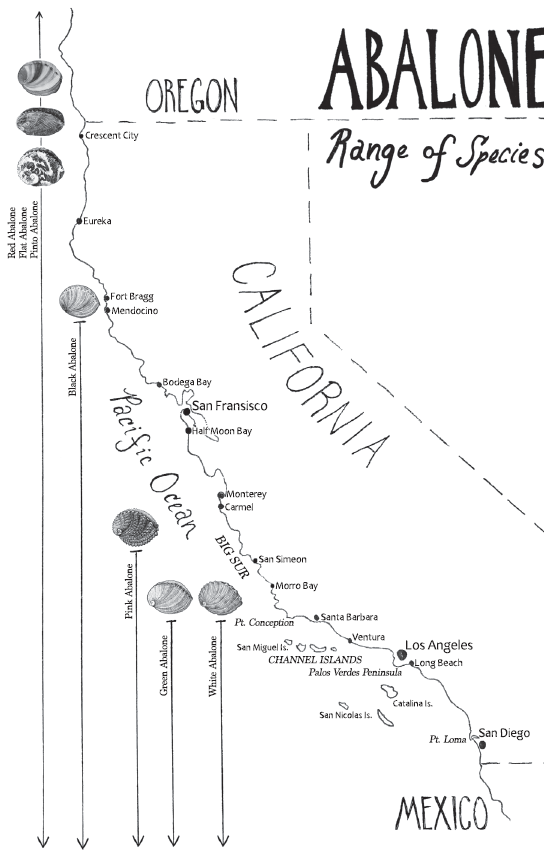
A MOLLUSK WITH CHARISMA
Ask anyone who spent time on Californias coast during the 1950s, 1960s, and early 1970s about abalone, and his or her eyes will likely brighten and then drift to a clear and potent memory: a beachside barbecue, summer vacation foraging in tide pools, or perhaps even plunging into deeper waters to pop the meaty shellfish from its rocky dwelling spots. At the time, Californias coast seemed awash in abalone. From San Diego to Crescent City, people gorged on abalone steaks, sandwiches, and burgers. Glimmering shells were sold in beach-town trinket shops, nailed to garden fences as signs of diving prowess, and shown off in living rooms as novel dcor or psychedelic ashtrays. Sunset Magazine routinely showcased abalone recipes and craft projects. Abalones remarkable abundance and appeal made them icons of Californias easy living, laid-back beach culture, and enduring natural opulence.
But by just a few decades later, many younger Californians had never seen or even heard of the legendary shellfish. In a relatively short period, the juicy steaks, ubiquitous shells, and animals that had long studded nearshore reefs vanished from central and southern California, remaining abundant only in northern California, for a time, owing to a tightly managed fishery.
In the past twenty years, two of Californias seven abalone species have joined the US endangered species list and four more have become species of concern. Just recently, even the red abalone in northern Californialong regarded as most hardyhas been devastated by a perfect storm of environmental stressors, resulting in the closure of the long-popular fishery. The few abalone species that range north into waters from Oregon to Alaska are at risk, too.
After millions of years of gripping tenaciously to North Americas western shoreline, after twelve thousand years of sustaining human foragers with their meat and of stirring human imagination with their iridescent shells, howin our timedid the fate of these delicious, wondrous, and once-abundant mollusks become so precarious?
The answer to that question, and any hope for these animals future, lies in understanding the remarkable history of people and abalone on the West Coast.

Consider first that we humans have regarded abalone primarily in relation to our own desires. People have long been intrigued by the captivating beauty of abalone shells and have long savored this creatures meat. Thousands of divers have been drawn to the bracing though sometimes dangerous sport and livelihood of foraging for this shellfish in its undersea haunts. People have loved the selves they become when wearing, hunting, and eating abalone. More than most animals, abalone have been cherished for their rich cultural values.
But keep in mind, too, abalone are also wild animals with their own requirements for survival.
Based on tiny fossils found in ancient marine strata of southern Californias coastal mountains, we know abalone have dwelled on the Pacific coast for at least seventy million years. After the notorious Cretaceous-Tertiary mass extinction event wiped out three-quarters of the Earths plant and animal species, including the dinosaurs, abalone remained absent from the fossil record for more than fifty million years until the Miocene Epoch, when the distinctive mollusks began to reappear as tiny, uncommon specimens, suggesting that some few pocket populations had managed to persist. About five million years ago, abalone became markedly larger and diversified into more distinct forms, but not until about 2.4 million years ago, the beginning of the Pleistocene, did the species we know today begin to come into existence.
It was during these eons before humans showed up that Pacific coast abalone came into their own. In an ocean full of the hungry ancestors of todays fish, octopuses, crab and, eventually, sea otters, abalones distinct anatomy evolved. The animals big muscular foot allows it to withstand the powerful force of waves and swells and also to clamp down hard on rocks and reefs, making its sturdy shell a formidable shield against predators that nonetheless drill and pry with relentless determination. The continual press of predation also consigned abalone to dwell in protective cracks and crevices, where their mostly sedentary lifestyle of waiting for currents to serve up bits and pieces of drifting kelp also evolved. And it may well be that some predatorsancestral sea otters by one theoryalso kept populations of kelp-eating competitors, such as sea urchins, in check, thus fostering an abundance of savory kelp in the North Pacific that enabled California abalones to eat well and grow large.
In the late eighteenth century, the great Swedish taxonomist Carl Linnaeus classified abalone into a genus of its own, Haliotis, honoring the long tradition of naturalists, stretching back to Aristotle, who had first named the Later naturalists catalogued abalone as gastropods (gastro for stomach and pod for foot)what we more commonly call snailsand eventually identified seven distinct species on the California coast, each living within particular ranges of depth and latitude reflecting fealty to water temperature.
Today we know that abalone survive on the rocky, submerged edges of five continents, and despite their wide range in size, all the worlds fifty-six delineated species share a large foot and an oval dome-shaped shell with a distinctive interior glimmer, a subtle flattened spiral, and an elegant line of respiratory pores.
The mollusks breathe by drawing water through these small holes to oxygenate gills inside. They use the same pores to expel water and waste and also to broadcast eggs and sperm, which must meet up in the chancy realm of seawater. Although abalone perceive light through primitive eyes, they know their surroundings through chemosensory means. With a fringe of tentacles that reach out from the edge of its big foot, an abalone can detect the scent of drifting kelp and then reach out to grab and draw the nutritious alga toward its mouth or under its shell to store for a later meal.
Font size:
Interval:
Bookmark:
Similar books «Abalone»
Look at similar books to Abalone. We have selected literature similar in name and meaning in the hope of providing readers with more options to find new, interesting, not yet read works.
Discussion, reviews of the book Abalone and just readers' own opinions. Leave your comments, write what you think about the work, its meaning or the main characters. Specify what exactly you liked and what you didn't like, and why you think so.

